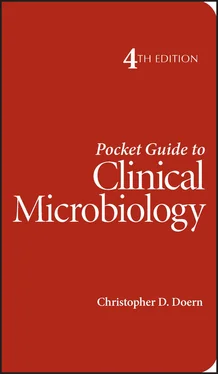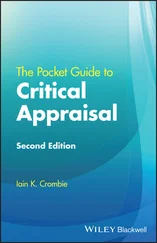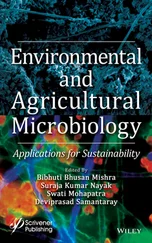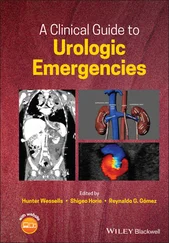Cover: “La peste en Mandchourie” Le Petit Journal n° 1057 du 19 Fev. 1911
Design: Lou Moriconi ( http://lmoriconi.com/)
Online: http://www.asmscience.org
To Drs. Carey-Ann Burnham, Mike Dunne, and Betz Forbes: invaluable mentors and dear friends .
The Pocket Guide to Clinical Microbiology is unique among reference texts in that its primary purpose is to present usable information in a concise and accessible manner. Now in its fourth edition, this iconic text has remained popular over the years because it has successfully condensed most of the information needed by the practicing clinical microbiologist into a pocket-sized guide. As Dr. Patrick Murray articulated in the preface of the third edition, with each iteration of this text the format has been honed to enhance its usability. Although the overall format of the fourth edition remains true to the template of previous editions, this edition reflects the tremendous evolution that has occurred in clinical microbiology over the past decade. In particular, three key advances have reshaped the practice of clinical microbiology, and have therefore, reshaped this edition.
First, the widespread adoption of matrix-assisted laser desorption/ionization time-of-flight mass spectrometry (MALDI-TOF MS) for organism identification has altered the way many laboratories practice clinical microbiology. Despite the fact that those using MALDI-TOF MS are less dependent on biochemical reactions to identify organisms, understanding biochemical profiles is still required for the troubleshooting of failed or ambiguous MALDI-TOF MS identifications. As such, this text has updated, but maintained, much of the biochemical reactions required to identify organisms the “old school” way. It is my belief that understanding and using these reactions to confirm organism identifications, remains one of the foundations of good clinical microbiology. This pocket guide should provide quick reference to everything the microbiologist needs to confidently identify most organisms encountered in the clinical laboratory. In addition, new information has been added in Section 8 that outlines the specifics of MALDI-TOF MS performance for individual bacteria, mycobacteria, and fungi.
Second, the development of molecular techniques has revolutionized the diagnosis of infectious diseases. Most notably, nucleic acid amplification testing (NAATs), also referred to as polymerase chain reaction (PCR), has drastically changed the practice of clinical virology to the extent that many laboratories no longer perform viral culture. Information regarding viral culture has been retained in this guide for labs still performing those techniques, but significant additions have been made throughout this edition to reflect the use of molecular diagnostics. Also, because gene sequencing is now a common technique used to identify bacteria and fungi, Section 8 contains new information to help interpret these results.
Third, the continued emergence of antimicrobial resistance poses significant challenges to clinical microbiologists as we struggle to provide treatment options for increasingly difficult-to-treat organisms. To reflect this reality, significant changes have been made to this pocket guide to help the microbiologist better perform and interpret antimicrobial susceptibility testing in the era of multidrug resistance. Acknowledging the international appeal of this text, I added new tables outlining guidance provided by both the Clinical and Laboratory Standards Institute (CLSI) and the European Committee on Antimicrobial Susceptibility Testing (EUCAST). The goal of these tables is to help the reader easily understand what methods can be used, and what interpretive criteria exist, for most organism/antibiotic combinations. Also included are tables with important intrinsic resistance profiles for commonly encountered organisms, as well as key mechanisms of resistance.
Sir Isaac Newton once said, “If I have seen further than others, it is by standing on the shoulders of giants.” Although I have no illusions that I have “seen further” than anyone else, the humility expressed in this quote resonates with me as I have undertaken the task of updating a text that was conceived and authored by Dr. Patrick Murray, one of the true giants of clinical microbiology. So first and foremost, I thank him for his work making this pocket guide the respected resource that it is. I hope that the fourth edition will do justice to the tradition of this text. In addition, I want to thank the talented, and patient, professionals at ASM Press. Specifically, Christine Charlip and Larry Klein, along with what I'm sure are countless others at ASM, warrant special thanks for all their work. And last, I thank my wife Kelli, who provided support and under-standing through the many late nights and weekends it took to complete this project. I could not have finished this project were it not for her support.
The practice of clinical microbiology is a wonderful discipline, requiring judgement, investigation, and critical decision-making to produce quality results. It is my hope that you will find this pocket guide to be a user-friendly reference that enhances your ability to do all of these things, and ultimately provide the best patient care possible.
Christopher D. Doern
Christopher Doern, PhD, D(ABMM), is an Assistant Professor of Pathology and the Director of Clinical Microbiology at the Virginia Commonwealth University Health System, Richmond, Virginia. He earned his undergraduate and doctoral degrees from Wake Forest University in Winston-Salem, North Carolina. Doern went on to a fellowship in Medical and Public Health Microbiology at the Washington University School of Medicine, St. Louis, Missouri, and is certified by the American Board of Medical Microbiology (ABMM).
Doern is an active member of the clinical microbiology community and serves on the ABMM, ASM Clinical Laboratory Practices Committee, Clinical Chemistry Trainee Council, and several Clinical and Laboratory Standards Institute document development and revision committees. He is an editor for the Clinical Microbiology Newsletter and serves on the Journal of Clinical Microbiology and Pediatric Infectious Diseases Journal editorial boards.
Doern is involved in educational programs that reach an international audience. Among these is the Medical Microbiology Question of the Day ( www.pathquestions.com), for which he has been an editor since 2011. This service provides freely accessible educational material to participants in more than 60 countries
SECTION 1
Taxonomic Classification of Medically Important Microorganisms
General Comments
Taxonomic Classification of Bacteria
Taxonomic Classification of Human Viruses
Taxonomic Classification of Fungi
Taxonomic Classification of Parasites
In order to remain true to the tradition set forth by the first three editions of this pocket guide, the first section will be devoted to describing the taxonomy of common (and some uncommon) organisms which are associated with humans and may be isolated by the Clinical Microbiology Laboratory. Unfortunately, in the 13 or so years that have passed since the third edition of the Pocket Guide was published, the rate of taxonomic changes has continued to increase such that publishing a taxonomic list of organisms would be out of date before this book goes to publication. This is a product of continued proliferation of new species of organisms which are being identified by increasingly sophisticated genomic analyses. As such, the revised goal of this section will be to outline some high-level taxonomic groupings and provide the resources and references one would need to identify the most up-to-date taxonomic classifications.
Читать дальше












